Services on Demand
Journal
Article
Indicators
-
 Cited by SciELO
Cited by SciELO -
 Access statistics
Access statistics
Related links
-
 Similars in
SciELO
Similars in
SciELO
Share
Revista odontológica mexicana
Print version ISSN 1870-199X
Rev. Odont. Mex vol.18 n.3 Ciudad de México Jul./Sep. 2014
Original research
Influence exerted by thermal changes in the transverse deflection of acrylic materials used for denture bases, with and without metallic inserts
Alejandro Osorio Naranjo,* Jorge Guerrero Ibarra,§ Alejandro Santos EspinozaII
* Oral Prosthesis Specialty.
§ Professor, Dental Materials Research Laboratory.
II Professor, Oral Prosthesis Specialty.
National School of Dentistry, National University of Mexico (UNAM).
ABSTRACT
The aim of the present in vitro study was to determine whether thermal changes influence the transverse deflection of two different brands of acrylic used for denture bases, with and without metallic inserts, after having been subjected to a thermo-cycling period with temperature changes. 40 acrylic samples were processed according to ADA's specification number 12. Four groups were made up, two with Lucitone 199 and two with ProBase Hot. Results were subjected to one-way ANOVA statistical analysis and comparison of Turkey groups with a value of (p > .001). Conclusion: Both acrylic materials used for denture bases fulfill specifications of ADA's norm number 12. Metallic inserts allowed the decrease of the acrylic deflection and thermal changes considerably affected physical characteristics.
Key words: Deflection, acrylic, thermal, denture.
INTRODUCTION
Polymethylmethacrylate (PMMA)1 is the material most used to manufacture denture bases. Walter Wright2 first introduced this material in 1937. By 1945 90% of all dentures were manufactured with this material due to its easy manipulation, biocompatibility, pleasing esthetics and low cost.3-5
Fractures of full dentures in denture-wearing patients have been widely studied. Among most frequent causes for these fractures are incorrect occlusal adjustments as well as inappropriate thickness of denture bases.6
Studies conducted on fixed provisional prostheses manufactured with acrylic resin have revealed the presence of maladjustments due to thermal changes,7,8 nevertheless, this has not been the case when using acrylic resins for denture bases.
Drs Yazdanie and Mahood6 attempted to improve impact resistance in acrylic materials used for denture bases. For this purpose they implemented a carbon fiber reinforcement, which did increase resistance to fracture. Blum7 reported contraction and expansion of samples of provisional fixed partial prostheses which had been subjected to cold thermo-cycling tests (4 ± 1 oC) and hot thermo-cycling (50 ± 2 oC), with an intermediate temperature of 37 oC. These tests elicited vertical and transversal (cross-sectioned) maladjustment. The author explains it arguing that patients, on a daily basis, ingest cold drinks (soft drinks) or hot food such as soup. To this effect, they sip 40 to 60 times per beverage or foodstuff, 15 to 20 for each in average, using approximately 4 seconds per sip, the denture then returns to 37 oC body temperature, this temperature change represents stress for the acrylic resins. The aforementioned reasons prompted the accomplishment of this thermo-cycling test. Dubois8 also reported the presence of maladjustment in the provisional fixed partial prostheses samples which were subjected to load as well as thermo-cycling. In these tests, greater change was observed when using hot temperatures (50 ± 2 oC). In Nagasaki, Japan, a test was conducted where 3,000 cycles were applied to samples with resin adhesion to dentin; they used the aforementioned temperatures to elicit volumetric changes in the materials. In the same test, 20,000 cycles were applied to composites adhered to metal.9 R. Alvizar measured the transverse deflection of two different brands of acrylic material used for denture bases, with and without metallic inserts. She reported that use of metallic inserts improved resistance to fracture.
METHOD
The present was an experimental study composed of 4 groups of 10 samples each, providing thus a total of 40 specimens. Samples of group «A» were made up with Lucitone 199 acrylic (Dentsply International Milford Delaware), this group did not have metallic inserts. Samples of group «B» were made up with Lucitone 199 acrylic (Dentaurum, Pforzheim, Germany), this group did have metallic insert. Samples of group «C» were made up with ProBase Hot acrylic (Ivoclar Schaan Liechstenstein) without metallic inserts. Samples of group «D» were made up with ProBase Hot acrylic with metallic inserts. All samples measured 10 mm wide x 65 mm long and 2.5 mm thick, in compliance with point 4.3.5 of ADA's number 12 specification10 for polymers used for denture bases.
Samples were manufactured with the lost wax process.Tothiseffect sheets of pink wax (Filenes, Mexico) were used. Samples were placed in a Hanau muffle with type IV plaster (Velmix, Whip mix, USA) (Figure 1). Once set, samples were dewaxed by immersing muffles for 12 minutes in boiling temperature water (92.8 oC in Mexico City), and later for 8 minutes in a Hanau curing unit (Hanau). Samples were then washed with bio-degradable detergent. Once the plaster was clean and dry, two coats of plaster-acrylic separator were applied (Nic Tone, Dental Continental, Mexico).Ten minutes were allowed to elapse for drying purposes. In both acrylics powder-liquid mix was performed observing the proportion of three parts of powder per one part of liquid. For group «A», acrylic mix was placed in type IV plaster molds with cellophane paper to be pressed in a hydraulic press (Mestra) at 10 lb/in2. Excess acrylic was removed and the muffle was finally closed (Figure 2). Procedure for group «B», Lucitone 199 with metallic insert was as follows: inserts were cut with a fine-grit carbide disk (Keystone USA), measurements were 8.5 mm wide x 63 mm long x 0.3 mm thick. In order to place metallic inserts in the samples, during the first pressing procedure, as well as cellophane paper (Figure 3) a 1 mm aluminum spacerwas used with the same measurements as the metallic insert. The aluminum spacer was then removed, the second pressing procedure was undertaken, and thus the muffle remained closed. Steps for group «C» (ProBase acrylic) were similar to those of group «A». Steps for group «D» (ProBase Hot) were similar to those undertaken for group «B». Polymerization was conducted in a Hanau oven, by immersion in water under controlled temperature. For groups «A» and «B» (Lucitone 199) immersion was 90 minutes at 72 ± 1o C), followed by boiling temperature for 30 additional minutes (92.8o C in Mexico City). For groups «C» and «D» (ProBase Hot), polymerization was also achieved by immersion into water, varying the curing cycle to boiling temperature for 40 minutes. This protocol represented one of the four polymerization alternatives proposed by the manufacturer. Once established time had elapsed, muffles of all four groups were immersed in water at room temperature: 23 ± 10 oC for 15 minutes,10 after this, they were left to cool for an additional 15 minutes out of the water. Before undertaking thermocycling procedure, samples were immersed in distilled water for 24 hours at constant 37 oC temperature in an oven (Felisa, Mexico). This procedure is called by some authors zero thermo-cycling.9 After this, they were subjected to 500 cycles in a thermo-cycler at an approximate speed of one cycle per minute, where samples remained in cold water for 20 seconds at a temperature range of 4 ± 1 oC, and then an additional 20 seconds in hot water at 55± 1 oC. This procedure was devised to simulate changes experienced by the acrylic materials placed inside the mouth when subjected to feeding processes. Samples were subjected to cross-sectioned (transverse) deflectiontest.Thistest was conducted in a universal mechanical test machine with an AFTI charge cell (Mecmesin, UK) which has been previously been calibrated to exert constant pressure, beginning with 14.71 N (1,500 g) from zero to one minute, increasing the load during the second half of the next minute to 4.90 N (500 g). The load was applied to three points, one at the center of the sample, 0.01 mm, and lateral points at a 50 mm ± 0.025 mm distance. The central point was equidistant to the other two. Loads were applied until the samples fractured (Figures 4 and 5).
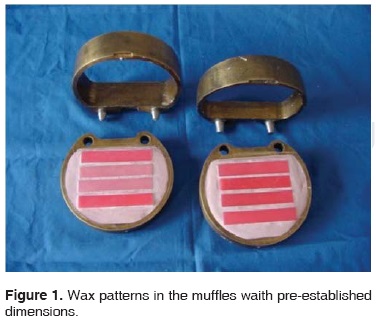
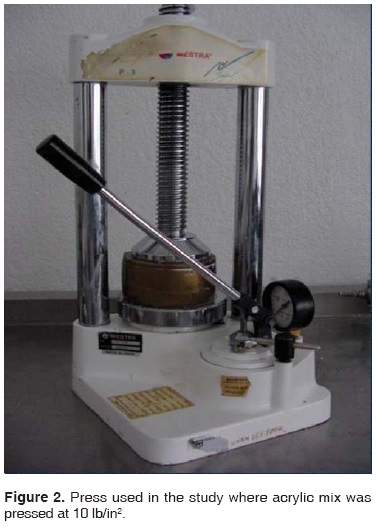
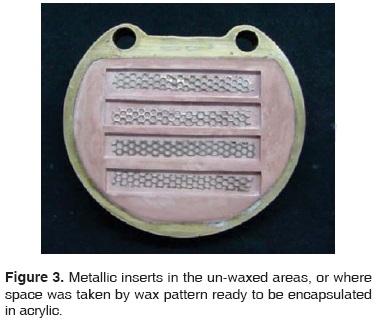
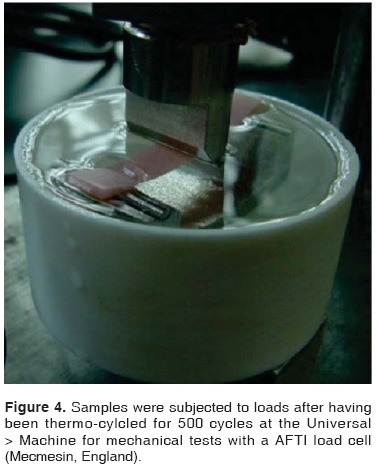

RESULTS
In group «A», deflection mean with 3,500 g was 1.93 mm ± .295. In group «B» it was 1.35 ± .247. For group «C» it was 1.953 ± .365. For group «D» it was 1.235 ± .128.
Deflection average, expressed in mm, with a 5,000 g load, was distributed in the following manner: group «A»: 3.808 mm ± .794. Group «B» 2.717 mm ± .5520. Group «C» 3.462 mm ± .650, group «D» 2.382 mm ± .307 (Figure 6).
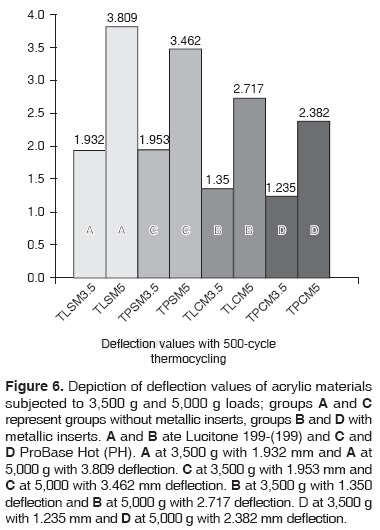
Comparison of deflection (in mm) with a 3,500 g load between groups «A» and «B» revealed statistically significant difference (t = 4.773, p < .001). A statistically significant difference (t = 5.859, p < .001) was equally found in ProBase groups (with and without mesh), that is to say, groups «C» and «D».
Nevertheless, when establishing comparison between deflection of groups «A» and «C», with a 3,500 g load, no statistically significant difference was observed (t = .141, p = .889). Likewise, when establishing comparison between groups «B» and «D» no statistically significant difference was found in deflection average (mean) with a 3,500 gload (t = 1.302, p = .209).
When establishing a comparison of deflection mean (average) in mm with a 5,000 g load between groups «A» and «B», a statistically significant difference was found (t = 3.356, p = .004). In groups «C» and «D» a statistically significant difference was found (t = 4.458, p = .001).
When establishing a comparison between groups «A» and «C», with a 5,000 load, no statistical significant difference was observed (t = .799, p = .443), as was the case with groups «B» and «D» (t = 1.676, p = .111) upon being subjected to the same load.
When establishing comparison among all groups, according to a one-way variance ANOVA test, and comparison with Turkey test, results obtained revealed a statistically significant difference in deflection average of groups «A», «B», «C» and «D» when controlling loads to 3,500 g and 5,000 g respectively (F = 36.46, p < .001).
DISCUSSION
Studies conducted by Dubois revealed that in samples of acrylic used for fixed provisional partial prostheses, the greatest deterioration was caused by hot temperatures. Cold temperatures were not exceedingly harmful. Likewise, in acrylic samples used in the present study, in deflection tests, there was deterioration after thermal changes. Nevertheless, the present study was unable to determine at which point one temperature predominated over the other, therefore additional research was deemed necessary.
With respect to the study conducted by R. Alvizar in samples manufactured according to characteristics requested in ADA's Norm number 12, with the same number of samples and groups, subjected to load but without thermo-cycling (R Alvizar), greater values of transverse deflection were obtained for Lucitone 199 acrylic when compared to results found in the present article. Samples manufactured with ProBase Hot exhibited lesser transverse deflection values when compared to those found in samples of this same acrylic in the present study, including samples with metallic inserts. With respect to studies conducted by Noguchi et al. and Takuo Tanaka, the common denominator of both studies lies in the deterioration elicited by temperature changes created by the thermo-cycling process.
CONCLUSIONS
• Both acrylic materials comply with requirements specified by Norm number 12 of the ADA for acrylic materials used for denture bases.
• Metallic inserts allow the decrease of deflection of acrylic materials used for denture bases.
• Clinical significance of the present article could be the establishment of the fact that stress-produced thermal changes in acrylic materials used for denture bases considerably affect their physical properties with thermo-cycling: once subjected to transverse thermo-cycling tests, it could be observed that Lucitone 199 became more rigid and ProBase Hot became more flexible than when they were just polymerized, once they were subjected to transverse (cross-section) deflection test.
REFERENCES
1. Winkler S. The History of Resins in Dentistry. Dental Clinics of North America. Ed. Saunders; 1975. [ Links ]
2. Vega J. Polímeros acrílicos en odontología. Materiales dentales en odontología. España: Ed. Ediciones Avances Médico Dentales; 1996. [ Links ]
3. Eick JD. Biological properties of denture base resins. Dental Clinics of North America. 1977; 21: 459-464. [ Links ]
4. Phillips RW. Skinner's science of dental materials. 9th ed. Philadelphia: WB Saunders; 1991. [ Links ]
5. Combe E. Materiales dentales. Materiales poliméricos para base de prótesis. España: Ed. Labor; 1990. [ Links ]
6. Yazdanie N et al. Carbón fiber acrylic resin composite: an investigation of transverse strength. J Prosthet Dent. 1985; 54 (4): 543-547. [ Links ]
7. Blum J et al. Effects of thermocycling on the margins of transitional acrylic resin crowns. J Prosthet Dent. 1991; 65 (65): 644-646. [ Links ]
8. Dubois RJ. Effects of occlusal loading and thermocycling on the marginal gaps of light-polymerized and autopolymerized resin provisional crowns. J Prosthet Dent. 1999; 82 (2): 161-166. [ Links ]
9. Tanaka T et al. A comparison of water temperatures for thermocycling of metal-bonded resin specimens. J Prosthet Dent. 1995; 74 (4): 345-349. [ Links ]
10. Revised American Dental Association specification no. 12 for denture base polymers. J Am Dent Assoc. 1975; 90 (2): 451-458. [ Links ]
Note This article can be read in its full version in the following page: http://www.medigraphic.com/facultadodontologiaunam Mailing address:
Mailing address:
Alejandro Santos Espinoza
E-mail: santosespinoza@gmail.com











 text in
text in 


